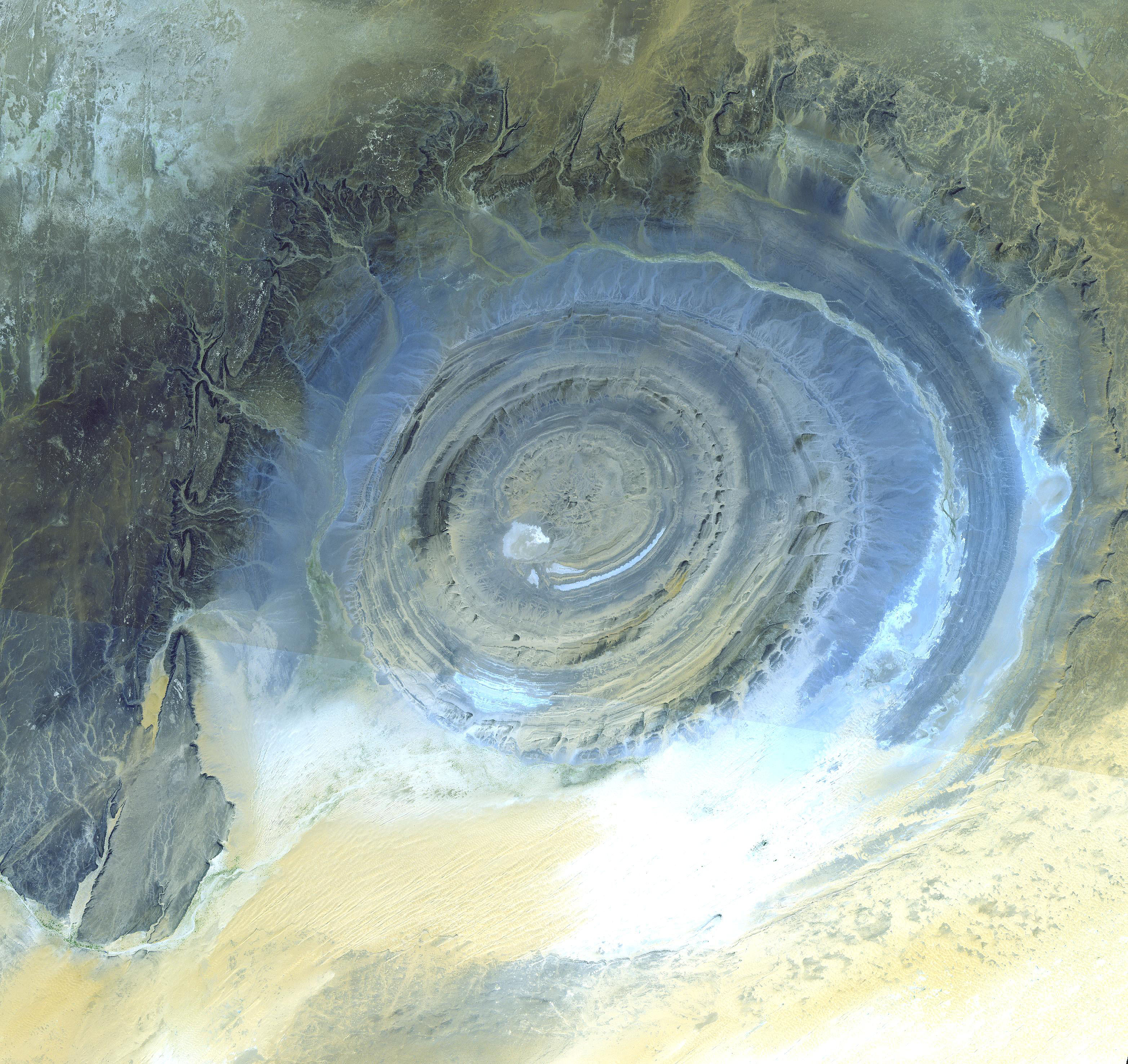dome (geology) on:
[Wikipedia]
[Google]
[Amazon]


 A dome is a feature in structural geology consisting of symmetrical
A dome is a feature in structural geology consisting of symmetrical


anticline
In structural geology, an anticline is a type of fold that is an arch-like shape and has its oldest beds at its core, whereas a syncline is the inverse of an anticline. A typical anticline is convex up in which the hinge or crest is t ...
s that intersect each other at their respective apices. Intact, domes are distinct, rounded, spherical-to- ellipsoidal-shaped protrusions on the Earth's surface. However, a transect parallel to Earth's surface of a dome features concentric rings of strata. Consequently, if the top of a dome has been eroded flat, the resulting structure in plan view appears as a bullseye, with the youngest rock layers at the outside, and each ring growing progressively older moving inwards. These strata would have been horizontal at the time of deposition
Deposition may refer to:
* Deposition (law), taking testimony outside of court
* Deposition (politics), the removal of a person of authority from political power
* Deposition (university), a widespread initiation ritual for new students practiced f ...
, then later deformed by the uplift
Uplift may refer to: Science
* Geologic uplift, a geological process
** Tectonic uplift, a geological process
* Stellar uplift, the theoretical prospect of moving a stellar mass
* Uplift mountains
* Llano Uplift
* Nemaha Uplift
Business
* Upli ...
associated with dome formation.
Formation mechanisms
There are many possible mechanisms responsible for the formation of domes, the foremost of which are post-impact uplift, refolding, and diapirism.Post-impact uplift
A complex crater, caused by collision of ahypervelocity
Hypervelocity is very high velocity, approximately over 3,000 meters per second (6,700 mph, 11,000 km/h, 10,000 ft/s, or Mach 8.8). In particular, hypervelocity is velocity so high that the strength of materials upon impact is v ...
body with another larger than itself, is typified by the presence of a dome at the centre of the site of impact. These domes are typically large-scale (on the magnitude of tens of metres) and thought to be the result of post-impact weakening of the overlying strata and basement. Weakening is integral for the vertical uplift required to create a dome to take place, as it allows vertical displacement to happen unconstrained by the original rigidity properties of the undeformed rock. This displacement is the result of the parcel of rock at the centre of the site of impact, composed of the strata and basement, re-equilibrating relative to gravity. Earlier theories attributed the dome-forming uplift to rebound; however, this would imply that the rock deforms elastically. Elastic deformation is not likely being that an impact is accompanied by extensive fracturing and partial melting of the rock that would change the mechanical properties of the rock.
Refolding
Structural domes can be formed by horizontal stresses in a process known as refolding, which involves the superposition, or overprinting, of two- or more fold fabrics. Upright folds formed by a horizontal primary stress in one direction can be altered by another horizontal stress oriented at 90 degrees to the original stress. This results in overprinting of the twofold fabrics, similar to wave interference patterns, that results in a system of basins and domes. Where the synclines of both fabrics are superimposed, a basin is formed; however, where the anticlines of both fabrics are superimposed, a dome is formed.Diapirism
Diapirism involves the vertical displacement of a parcel of material through overlying strata in order to reach equilibrium within a system that has an established density gradient (see Rayleigh–Taylor instability). To reach equilibrium, parcels from a stratum composed of less-dense material will rise towards Earth's surface, creating formations that are most often expressed in cross-section as “tear drop”-shaped, where the rounded end is that closest to the surface of the overlying strata. If overlying strata are weak enough to deform as the parcel rises, a dome can form; in cases where the overlying strata are particularly devoid of resistance to applied stress, the diapir may penetrate through the strata altogether and erupt on the surface. Potential materials comprised by these less-dense strata include salt (which is highly incompressible, thus creating the structural instability that leads to diapirism when buried under deposited strata and subject to overlying stress) and partially melted migmatite (a metamorphic-texture rock frequently found in domes due to the typical involvement of heat and/or pressure with their formation).Examples
Impact structures
* Upheaval Dome, Utah, USA * Vredefort Dome, South AfricaRefolded (structural) domes
*Observed in the Karatau fault system, Kazakhstan *North Pole Dome, Western Australia (in the Pilbara Craton)Diapiric domes
* Mabja Dome, southern Tibet * Leo Pargil Dome,Himachal Pradesh
Himachal Pradesh (; ; "Snow-laden Mountain Province") is a state in the northern part of India. Situated in the Western Himalayas, it is one of the thirteen mountain states and is characterized by an extreme landscape featuring several pea ...
/Tibet
Tibet (; ''Böd''; ) is a region in East Asia, covering much of the Tibetan Plateau and spanning about . It is the traditional homeland of the Tibetan people. Also resident on the plateau are some other ethnic groups such as Monpa people, ...
an border
Disputed origin
* Richat Structure, central MauritaniaSee also
*Dome illusion
In astronomical imaging and Earth imaging, the crater illusion, also known as the dome illusion or crater/dome illusion, is an optical illusion which causes impact craters and other Depression (geology), depressions to appear raised as Dome (geol ...
References
{{Commons category, Natural domes Rock formations Structural geology Tectonic landforms